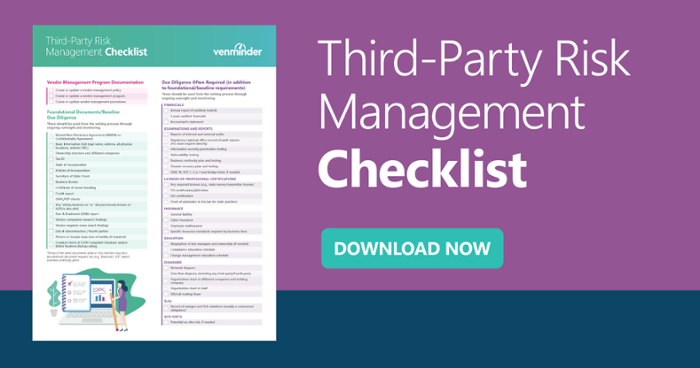The other day we were reading a great article by Steve Tobak, author of “Real Leaders Don’t Follow,” about prioritizing time. Although the article was released about 6 years ago, the relevancy is still there. Prioritizing assignments and/or tasks properly is a common pitfall for many. However, Steve takes a unique approach to grouping tasks. You’ll have 3 buckets:
- Priority A: Critical Things
- Priority B: Business as Usual
- Priority C: Everything Else
To make it even clearer, and maybe a little surprising from first glance at the groups, Steve says he spends nearly all of his time on the Priority B activities. Priority A activities interrupt his time spent on Priority B as they come up.
How does this relate to vendor management? Well, in vendor management especially, you must be able to prioritize tasks and you must be able to do it well to remain on top of your vendor management game. There’s so much to do all of the time, so it’s important to have your tasks mapped out by priority.
Examples of Vendor Management Tasks
Here’s an example of a Priority A, Priority B and Priority C vendor management task list:
Priority A: Critical Vendor Managements Tasks
There’s urgency! Some scenarios where you need to essentially stop what you’re doing and get focused on the task at hand immediately include the following:
- Vendor management policy, program and procedures documents. These documents are the foundation of your vendor management program. If you haven’t carefully crafted them, it can lead to many inconsistencies, inefficiencies and confusion at your organization regarding vendor management processes and expectations.
- Notice of examination. If you receive notice of an exam, it’s not something to take lightly. Don’t shove it aside because you’ll “get to it later” as that never bodes well for anyone. Exams are very important and timely as well as take a lot of preparation.
- You or your vendor experience a data breach. This is huge! Your notification to your customers regarding the breach must be very timely so that it doesn’t negatively impact your reputation – more than it’s unfortunately already going to. A quick response time also helps with keeping customer trust.
- You learn of a new vendor when a problem occurs. Time to focus on re-educating the front line business areas on the process to ensure this doesn’t happen again, and perhaps, time to revisit your entire vendor lists with Accounts Payable to make sure there aren’t others that have been missed.
Priority B: Business as Usual Vendor Management Tasks
Some business as usual tasks often include:
- Prioritizing contract dates. Of course, when reviewing contracts, you should put even more focus on the ones coming up for renewal or nearing expiration sooner than others. This means if a contract is coming up for renewal, you need to go through your due diligence again, the risk assessment process and reviewing the contract and contract renewal to determine your next steps. Does it make sense to continue with the product or service or is time to evaluate other options? You’ll be focusing on reviewing this information in the appropriate order of urgency every day.
- Terminating poor vendor relationships. And, this is another reason you need to stay on top of contract dates and prioritize by most urgent. If you have a contract coming up for renewal but you know immediately you don’t want to re-sign, there are going to be steps that you’ll want to take, sooner rather than later, like reviewing the contract’s exit strategy requirements.
- Expired vendor risk assessments. Is there an expired vendor risk assessment that you haven’t completed? Once it’s overdue by 30 days then that should be moved up your prioritization list and become a focus. Ideally, it should be a part of your team’s performance goals that a risk assessment data is NEVER missed.
Priority C: Everything Else Vendor Management Tasks
Here are some scenarios where you may find that you have something that you need to get done; however, it may not be a pressing priority over some of the other more tasks requiring immediate attention. Although, unlike in the article where Priority C tasks almost never become main priorities that are addressed, you DO need to make sure you check these off your list at some point. They do need to get done, too. Here are some examples:
- Missing vendor due diligence. I want to preface this with it’s a case-by-case situation and sometimes it may be necessary that you move a missing due diligence from Priority C to a Priority B item. However, if you notice you’re missing a vendor due diligence document that you need to request that isn’t as urgent in the hustle and bustle of all the things that need to get done and if you need to move that task down your list to accommodate some other critical items, that can be okay at times. Just make sure you request it as soon as possible, store it properly and document your analysis.
- Recently signed contracts. While continued oversight is a must and very critical, if you just signed a contract, there’s likely no immediate need to do more due diligence on the vendor. This is because you should have already gone through the initial vendor vetting and due diligence process. This means, you can move that vendor and/or contract review to lower on your list and tackle some of the other priorities.
A successful vendor management program takes a disciplined and organized approach. And, bucketing tasks in this manner can help ease stress and add clarity.
Ensure you have the right vendor management documents and procedures in place. Download the checklist.



















